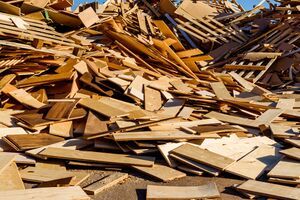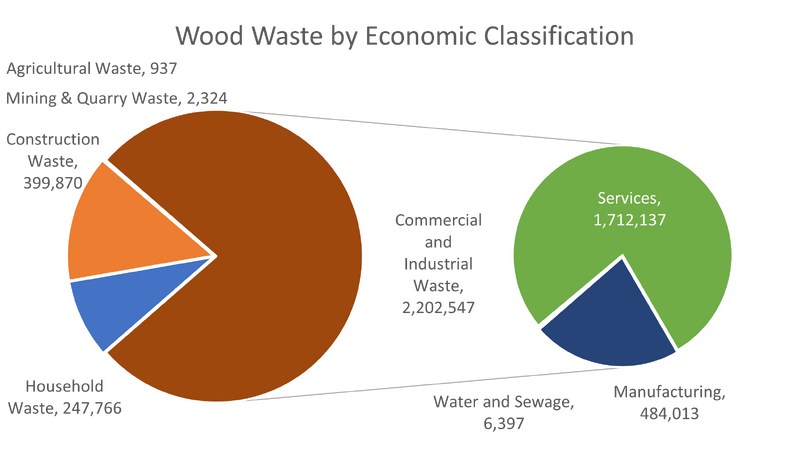Wood Waste
Wood Waste is wood which is not virgin timber (that is, wood that has been used for any purpose) and associated residues such as off-cuts, shavings chippings and sawdust, either treated or not treated, is waste. They remain waste and subject to waste regulatory control until completely recovered[1]. The overall size of the Wood Waste market in the UK is estimated to be around 4,500,000 tonnes.

Macro Tonnages
DEFRA
The most recent information published by DEFRA [2] is summarized in the pie chart below, with 3,275,463 tonnes of wood generated in the UK in 2020 and is part of the broader tonnage summarised in UK Waste Tonnage:

Whilst the macro numbers show 3,275,463 tonnes the general view of several market commentators [3] was that the total wood arising was between 4,500,000 and 5,700,000 tonnes and this can be accounted for a the DEFRA data being unable to identify wood in the mixed waste streams - this wood then may or may not be pulled out at MRFs or other similar Treatment facilities - and because some wood is recycled through sites exempt from permitting which results in the figures under-reporting totla tonnage.
Wood Recycling Association
In June 2025 the Wood Recyclers' Association reported their annual statistics on wood waste for 2024 [4] as follows:
- Arisings of wood waste that were broadly at c. 4.5 million tonnes
- Processed wood waste was at c. 4.4 million tonnes
- 2.8 million tonnes went to 'Chapter IV compliant biomass facilities' (Biomass EfW - WikiWaste figures for 2024 suggest this figure was closer to 2.6 million tonnes)
- Small scale Biomass EfW accounted for 90,000 tonnes per year
- 920,000 tonnes went to panel board manufacture
- 310,000 tonnes went to animal bedding
- Exports with imports netted off to 211,000 tonnes
Market Overview
The overall size of the Wood Waste market in the UK is estimated to be between 4,500,000 tonnes and 5,000,000 tonnes, categorized into Grades A to D according to its level of contamination. Where virgin wood is mixed with waste wood such as fence posts, pallets, construction boarding or other waste, the mixed load is considered waste[1].
DEFRA figures accounted for 3,275,463 tonnes of wood waste in their most recent 2020 figures, the remaining tonnage being left in mixed waste streams. The separated wood waste is primarily used in animal bedding, as recycled wood panel board and in Biomass EfW. The use in Biomass EfW has increased rapidly over recent years from 1,630,000 tonnes in 2017 to around 2,800,000 tonnes in 2020.
Wood Waste Grades
Treated waste wood is wood that has been treated by being injected, impregnated, sprayed, infused (soaked) or surface coated with any organic or inorganic substances for the purposes of preserving or protecting it or for changing its appearance. Some of these treatments may not be obvious and visible. Surface coating includes varnishes and paints, glues and non-natural veneers[1].
Main Grades
Waste wood is categorized into 4 different types; Grade A-D. This is based on the quality of wood, the utilization of the wood, and type/amount of contaminants[1] with
- Grade A being primarily clean wood off-cuts
- Grades B and C representing increasing quantities of chipboard, MDF and laminated wood with wood off-cuts, and
- Grade D representing treated wood that is generally classified as Hazardous Waste (although at the present time this is not generally segregated for collection and treatment/disposal in the UK and is mixed with Grade B and C Wood Waste).
Hazardous Waste Wood
A number of EA Regulatory Position Statements RPS were issued and then withdrawn from 2020 onwards, with the most recent RPS withdrawn on the 11th September 2024[5]. These were generally created to ensure hazardous waste wood within mixed non-hazardous waste wood was appropriately classified, stored and managed. The note to the most recently withdrawn RPS states: 'The Environment Agency is satisfied that the amount of ‘amber’ items of hazardous waste wood is very low and diminishing'.
Waste wood that is known and is classified as hazardous such as:
- railway sleepers
- telegraph poles
- wood treated with creosote
must continue to be segregated and consigned as Hazardous Waste.
Local Authority Tonnage
The wood types listed below represent those categories used by local authorities for the wood they manage, primarily at HWRC sites, which do not correlate with the Grade A to D approach due to the way the data is collected through WasteDataFlow.
Chipboard and MDF
Chipboard is a hard material made out of very small pieces of wood which have been pressed together. It is often used for making doors and furniture[6].
MDF is an abbreviation for medium-density fibreboard, it is a wood-substitute material used in interior decoration[7].
Below is a list of local authorities that sends more than 4000 tonnes of this material to a single waste operator.
| Authority | Stream | Facility | Operator | Address | Material | Tonnes | Reporting Year |
|---|---|---|---|---|---|---|---|
| Nottinghamshire County Council | Source segregated recyclate | Reprocessor - recycling (qu19) | Timberpak Ltd | Cross Green Vale, Cross Green Ind Est, Leeds, West Yorkshire | Chipboard and mdf | 9,188.99 | Apr21 - Mar22 |
| South Lanarkshire | Source segregated recyclate | Reprocessor - recycling (qu19) | Not Available | Not Available | Chipboard and mdf | 7,297.03 | Jan21 - Dec21 |
| Cheshire East | Source segregated recyclate | Reprocessor - recycling (qu19) | R Plevin & Sons Ltd | Cheshire Street, Mossley, Ashton Under Lyne, Lancashire | Chipboard and mdf | 6,065.50 | Apr21 - Mar22 |
Composite Wood Materials
Wood composites include a range of different derivative wood products, all of which are created by binding the strands, fibers or boards of wood together. It is also referred to as man-made wood, manufactured board, engineered wood, or wood-plastic composite (WPC) when using wood fibers and thermoplastics. They are fixed using adhesives and are engineered to certain specifications, resulting in a material that can have diverse applications[8]. Wood composites are usually made from the same hardwoods and softwoods used for timber, except when using scraps and wood waste, and are created by mixing ground wood particles with heated thermoplastic resin. Both virgin and recycled thermoplastics are used, with polyethylene-based products being the most common. Composite wood materials are used in a wide range of applications arising mainly from household, industrial and construction sources[8].
Below is a list of local authorities that sends more than 1000 tonnes of this material to a single waste operator.
| Authority | Stream | Facility | Operator | Address | Material | Tonnes | Reporting Year |
|---|---|---|---|---|---|---|---|
| Cardiff County Council | Source segregated recyclate | Reprocessor - recycling (qu19) | Other/Exempt | JM ENVIROFUEL; JM ENVIROFUELBerth 31 Wimborne Road, Barry CF63 3DHEPR/AB3690CP | Composite wood materials | 5,308.48 | Apr21 - Mar22 |
| Edinburgh, City of | Source segregated recyclate | Other Method | Not Available | Not Available | Composite wood materials | 3,326.18 | Jan21 - Dec21 |
| Gwynedd Council | Source segregated recyclate | Reprocessor - recycling (qu19) | Hadfield Wood Recyclers Ltd | Lumb Lane, Droylsden, Manchester | Composite wood materials | 1,425.93 | Apr21 - Mar22 |
Wood
Below is a list of local authorities that send more than 20000 tonnes of this material to a single waste operator.
| Authority | Stream | Facility | Operator | Address | Material | Tonnes | Reporting Year |
|---|---|---|---|---|---|---|---|
| Greater Manchester WDA (MBC) | Source segregated recyclate | Reprocessor - recycling (qu19) | Hadfield Wood Recyclers Ltd | Lumb Lane, Droylsden, Manchester | Wood | 42,760.47 | Apr21 - Mar22 |
| Worcestershire County Council | Source segregated recyclate | Reprocessor - recycling (qu19) | Dew Mr David & Dew Mr Jonathan | Unit 100, Blackpole Road, Blackpole Trading Estate, Worcester, Worcestershire | Wood | 33,990.98 | Apr21 - Mar22 |
| Hampshire County Council | Source segregated recyclate | Reprocessor - recycling (qu19) | Multiple destinations | Multiple | Wood | 26,590.90 | Apr21 - Mar22 |
| Lancashire County Council | Source segregated recyclate | Reprocessor - recycling (qu19) | Sita ( Lancashire ) Ltd | Clifton Marsh Landfill Site, Lytham Road, Clifton, Preston, Lancashire | Wood | 22,299.41 | Apr21 - Mar22 |
Wood for composting
Below is a list of local authorities that sends more than 2000 tonnes of this material to a single waste operator.
| Authority | Stream | Facility | Operator | Address | Material | Tonnes | Reporting Year |
|---|---|---|---|---|---|---|---|
| Aberdeenshire | Mixed green and food waste | In vessel composting | Not Available | Not Available | Wood for composting | 10,075.66 | Jan21 - Dec21 |
| Dorset Council | Source segregated recyclate | Reprocessor - recycling (qu19) | Eco Sustainable Solutions Ltd | Chapel Lane, Parley, Christchurch, Dorset | Wood for composting | 6,425.22 | Apr21 - Mar22 |
| Dorset Council | Source segregated recyclate | Reprocessor - recycling (qu19) | Mark Farwell Plant Hire Ltd | Dow End Farm, Bushes Road, Stourpaine, Blandford Forum, Dorset | Wood for composting | 2,131.98 | Apr21 - Mar22 |
References
- ↑ 1.0 1.1 1.2 1.3 Environment Agency, 2017. Waste Wood Quick Guide 43_17 Issued 02/03/2017. London.
- ↑ UK Statistics on Waste 2020
- ↑ , Wood Recycling Association website 4.5mt; Tolvik 2017 Report 5.0mt and Anthesis (Tolvik report reference unobtainable) 5.7mt
- ↑ https://woodrecyclers.org/uk-waste-wood-market-remained-buoyant-in-2024-with-over-96-of-material-processed/
- ↑ https://www.gov.uk/government/publications/storing-and-treating-hazardous-waste-wood-rps-291/storing-and-treating-hazardous-waste-wood-rps-291
- ↑ Collins, 2019. Definition of chipboard. Collinsdictionary.com. [online] [Accessed 4 Dec. 2019].
- ↑ Collins, 2019b. Definition of MDF. Collinsdictionary.com. [online] [Accessed 4 Dec. 2019]
- ↑ 8.0 8.1 Johnson, C. 2017. Wood Composite - The Alternative, Sustainable Solution to Timber. Build Abroad. [online] [Accessed 5 Dec. 2019].
